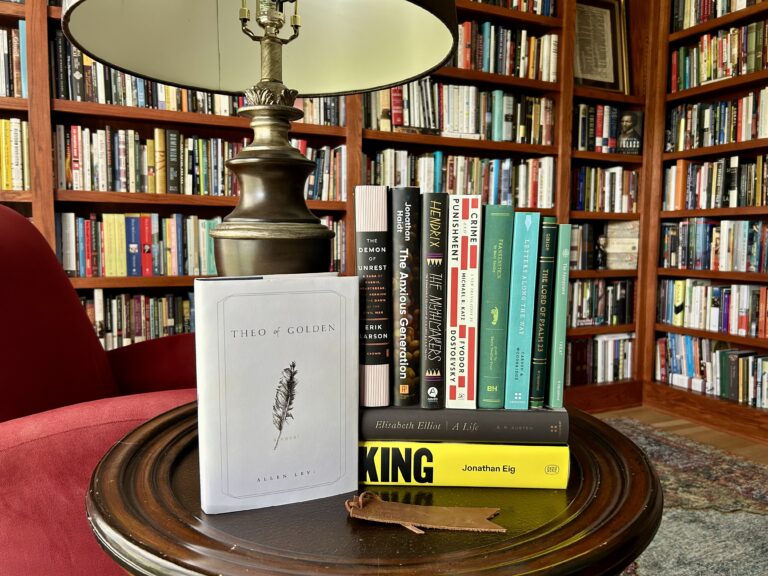Does expressive individualism—the “be true to yourself” framing of life that finds purpose in “finding” and then “expressing” the real you inside—work? Does it satisfy? Or does it fall apart due to internal contradictions?
These are questions I’ve raised in recent years—from a multi-part blog series to my book Rethink Your Self. I’ve sought to explain how expressive individualism, while not without insights into truths that matter for human flourishing, ultimately leads to a dead end in our pursuit of joy. The world says to look in first, but the Bible says to look up — to God and what He has revealed about the purpose and meaning of human life, through nature and especially in His Word.
But it’s not enough to show that expressive individualism is an ultimately unsatisfying way to live, with internal contradictions that become increasingly clear as life goes on. There are also circumstances where expressive individualism kills. It’s a dead end that leads to, well, death. And I’m not referring only to eternal consequences for rejecting Jesus in favor of a life philosophy that enthrones the self. I mean physical death here and now.
Expressive Individualism and Abortion
Nowhere is the link between expressive individualism and death clearer than in one of the longest and most protracted debates facing our country—the right to abortion. Although I’ve always thought Justice Anthony Kennedy’s famous “mystery of life” opening to the controversial 1992 abortion case Planned Parenthood vs. Casey provided a good summation of expressive individualism, I’d never considered how much this way of thinking frames the legal debate surrounding abortion.
O. Carter Snead’s book What It Means to Be Human: The Case for the Body in Public Bioethics (Harvard University Press, 2020) argues that the dominant anthropology of American public bioethics is expressive individualism. Here’s what he means.
- Individualism: “The fundamental unit of human reality is the individual person, considered as separate and distinct from the manner in which he is or is not embedded in a web of social relations. Persons are identified with and defined by the exercise of their will—their capacity for choosing in accordance with their wants and desires.” (69-70)
- Expressive: “Individuals thrive insofar as they are able to freely create and pursue the unique projects and future-directed plans that reflect their deeply held values and self-understanding. These projects and purposes emerge from within the self; neither nature, ‘natural givens,’ nor even the species-specific endowments and limits of the human body dictate the end of individual flourishing.” (70)
The view of humanity that undergirds many of the laws surrounding these pressing issues is individualistic at its core, with assumptions borne of an expressivist logic. On abortion legal jurisprudence, Snead writes:
The law proceeds from the assumption that the core unit of reality is the atomized and isolated self, lacking any unchosen constitutive attachments, along with the obligations and benefits that might flow from them. It reduces the person to a lonely agent of desire, defined by the will and the capacity to make choices, whose highest thriving is self-definition and the pursuit of economic and social aspirations. (168)
Given these suppositions about what it means to be a person, Snead points out, we shouldn’t be surprised that when confronted with the question of abortion the Supreme Court did two things:
- discover “a constitutional right to self-determination––under the variable and shifting auspices of privacy, liberty, and equality––to exercise ‘self-help’ in the form of abortion so as to overcome the burdens and obstacles to pursuing one’s chosen destiny, whether they be imposed by others, the state, or perhaps even nature itself.”
- exclude from the “community of legal persons those living human organisms not yet capable of actively discerning, inventing, and pursuing the projects essential to self-definition.” (169)
In other words, the individualist assumption prioritizes self-determination, and the expressivist assumption counts only those capable of making such choices as “human persons” in the first place. Put these two assumptions together, and the logic of expressive individualism leads to the death of the unborn. Snead writes:
“In a world of atomized wills locked in conflict with one another (and other sub-personal beings), the right of private force is essential to preserving the fundamental right to express one’s identity and to pursue one’s chosen destiny. And this right is particularly weighty when balanced against the interests of nonpersons…Viewed in this light, the Court’s rendering of the constitutional right to abortion is best understood as the liberty to protect and vindicate the most important goods at the heart of expressive individualism.”
Missing the Body
To be clear, pointing out this connection with abortion doesn’t mean there is nothing true or insightful in expressive individualism. I write in Rethink Your Self about the benefits of living in a society where “looking in” (the individual comes first) takes priority over “looking around” (the community comes first), just as there are benefits and drawbacks in the more community-centered view of life also. Snead also recognizes positive aspects: expressing what you believe to be true of yourself can be a “fruitful and dynamic source of meaning” as well as a “catalyst for promoting justice and resistance to conventional but repressive ideologies” (171).
The problem, Snead points out, is that expressive individualism isn’t the “whole truth” about human beings. He believes the philosophy, and by extension our laws that assume its framing, fail to seriously consider “embodiment and its meaning and consequences,” blinding the Court to “the reality of vulnerability, dependence, and natural limits that necessarily attend any problem or conflict involving embodied beings” (172).
Abortion as a Clash of Strangers
By stressing the atomized individual, the Court views the “mother” and “child” not in biological, embodied relationship, but as if they are “competitors over scarce resources necessary to pursue their own individual interests… a clash of strangers each seeking its own advantage.” Think about some of the most famous arguments for abortion; they build on analogies that liken the unborn child to trespassers, tumors, parasites, or kidnappers.
Snead writes:
The Court’s reasoning…misses this relationship and, in doing so, the opportunity to reflect on the fact that the parental relationship is not the transactional domain of consent, but is the pristine case of uncalculated giving and graceful receiving. It is the singular experience that “takes one outside of him or herself,” and transforms him or her from an “I” to a “we.” A child does not and need not earn the privilege of her parent’s care. The parent does not contract to take on such obligations. Being a parent means being responsible for the neediness of one who it utterly dependent and vulnerable, regardless of what one might receive in return. A parent takes on this duty by virtue of an embodied, biological relationship. Human beings begin their lives in utero already embedded in the relationship of children to parents. (173)
Expressive individualism obscures this relationship, and because it makes the purpose of life synonymous with the exercise of one’s individuality and pursuit of authenticity, human beings who do not have higher cognition or self-awareness, or who cannot express their desires are reduced to the status of “nonpersons” unless someone who can think and fend for herself chooses to see the fetus as belonging to the human family. Snead concludes:
Through the frame of expressive individualism, and by ignoring the embodiment and the goods, virtues, and practices necessary to responding to its challenges, the Court is left with only one option to respond––the freedom to use force to terminate the prenatal life that constitutes a threat to the individual woman’s future. (176)
This outcome impoverishes everyone, not just the unborn child and the woman. It weakens societal ties: between the father and mother, and other family members, and even community members who might otherwise feel obliged to come to the aid of a family in distress, or supply assistance to a woman in a vulnerable situation.
Until I read O. Carter Snead’s book on anthropology and embodiment, I had never considered the connection between American laws on abortion and expressive individualism. His argument goes into greater detail than I’ve summarized here, and he applies the same thinking to euthanasia and end-of-life choices, as well as reproductive technologies like IVF. Overall, he makes a persuasive (albeit chilling) case that a reductionist view of humanity can make a tomb of the womb.
If you would like my future articles sent to your email, please enter your address.

















